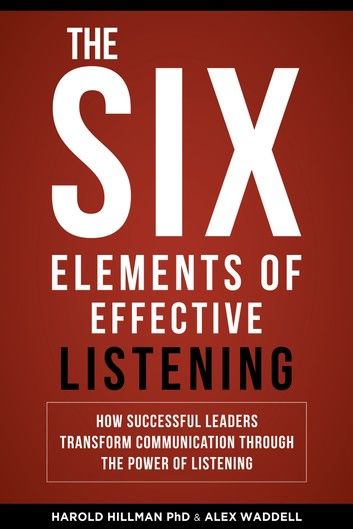| FindBook |
|
有 1 項符合
Sigmoid Curve Consulting Group的圖書 |
 |
$ 0 電子書 | The Six Elements of Effective Listening: How Successful Leaders Transform Communication Through the Power of Listening
作者:Harold Hillman,Alex Waddell 出版社:Sigmoid Curve Consulting Group 出版日期:2016-02-29  看圖書介紹 看圖書介紹
|
|
|
There’s an important distinction between hearing and listening. To hear is about receiving input. Listening gives meaning to that input. Yet, many people take listening for granted, treating it as a passive activity rather than a skill that you actively build. If you want to communicate better, it may be time to do a re-frame on what it means to really listen to someone.
You’ll never be a good listener if you have nothing to learn. You can’t be influenced to see things differently if you don’t believe there’s anything to learn from another person….or from the team. When people engage with you in conversation, do they experience someone who is open or closed? Helpful or unhelpful? If your goal is to be a better teammate, you don’t want to leave these questions to chance.
Think about active listening as switching between channels on a television, where you listen with a different ear depending on what’s required in the conversation. Your ability to switch channels is especially helpful when someone at work asks you to help them think through something difficult or complex. To be a better teammate, you should ask this question more frequently: How do you want me to listen?
There are six ways to listen more effectively in a conversation:
1. Listening with Compassion. When a person asks you to listen, don’t assume that they need you to do anything, or fix anything for them. Sometimes all they really want is for you to understand what an experience has been like for them, especially something difficult. Put simply, they just want you to listen to how they feel.
2. Listening to Reflect. When you listen to reflect, you are serving as a mirror to the person – to play the person’s words back to them, so they can hear it in a way that you’re hearing it. You sound pretty angry – is that how you really feel about it? When you listen to reflect, it helps the person to re-calibrate around both the message and underlying sentiment.
3. Listening for Assumptions. This listening style requires you to listen intently because your goal is to pull out every assumption that you think might be worth testing. An example of listening for assumptions would be: You’re saying that our older customers won’t mind the shift to younger styles – is that a fair assumption? Questions like this will slow the conversation down, but may save the team months of clean-up if an assumption is faulty.
4. Listening as the Contrarian. This style gives you permission to listen as the opposition – and to point out all the holes you hear in their argument. This listening style is especially helpful if the team tends to have safe and cautious conversations, or rushes to decisions without vetting all possible risks. The contrarian can bring out things that might otherwise go unspoken.
5. Listening for Balance. Balance comes in many forms and shapes. There are countless polarities that often get skewed in one direction or the other. It helps if someone on the team plays an active role to make sure that there is no gaping hole caused by some view point that is missing. Listening for balance is especially helpful if a person is rigidly locked onto a position, or the team is full of people who think in one particular way.
6. Listening for the System. Sometimes on a team, people are myopic around their own issues and no one listens to hear how the whole system is impacted. It undermines performance when they take their collective eye off the bigger picture. This listening style is especially important when people who are not involved in the conversation will still be affected by the decision.
When results really do matter to a team, they work hard to have high quality conversations. That can’t happen if everyone is talking and no one is listening. This book will make it easier to ask the question: How do you want me to listen? That can truly make the difference between good and great.
|











